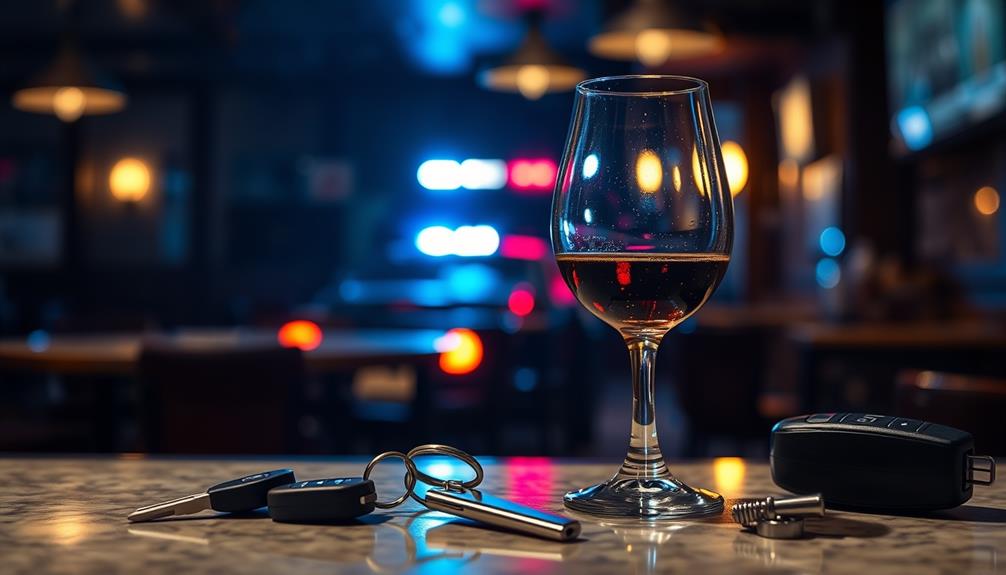You might think you can drive after just one drink, but it's not that straightforward. Even a single drink can impair your judgment and reaction times, putting you at risk on the road. While Texas sets the legal BAC limit at 0.08%, impairment can begin below that level. Individual factors like your weight and metabolism play a big role in how alcohol affects you. To guarantee safety, consider transportation options like rideshares or a designated driver. Making responsible choices now can prevent serious consequences later. Want to know more about staying safe after drinking?
Key Takeaways
- Consuming one drink can still lead to measurable blood alcohol levels, potentially affecting your driving ability.
- Individual factors like weight and metabolism influence how alcohol impacts your judgment and coordination.
- The legal BAC limit in Texas is 0.08%, but impairment can begin below this level.
- It's safer to plan alternative transportation, like rideshares or a designated driver, after drinking.
- Understanding your personal alcohol tolerance is essential for making responsible choices about driving after drinking.
Understanding Blood Alcohol Concentration

When it comes to understanding Blood Alcohol Concentration (BAC), it's vital to grasp how even small amounts of alcohol can impact your ability to drive. In Texas, the legal limit for BAC is 0.08% for drivers aged 21 and older.
You might think that after just one drink, you're still good to go. However, even a single drink can lead to a measurable blood alcohol level that affects your judgment and coordination. It's also important to note that the effects of alcohol can vary markedly based on individual health factors and circumstances, similar to how cold medications can affect your daily activities.
Typically, a BAC of 0.08% can be reached after consuming 2-3 standard drinks within one hour, but this varies widely based on personal factors like weight, metabolism, and whether you've eaten. It's vital to remember that impairment can begin even at levels below the legal limit. The effects of alcohol can sneak up on you, making driving in Texas risky after drinking.
For commercial drivers, the stakes are even higher with a stricter BAC limit of 0.04%. If you're under 21, any detectable alcohol can lead to serious penalties due to a zero-tolerance policy.
Effects of Alcohol on Driving

Even after just one drink, you mightn't realize how alcohol can impair your driving abilities.
Research indicates that even minimal consumption can lead to breast cancer symptoms such as impaired judgment and slowed reaction times, starting with low levels of alcohol.
The risks of impaired judgment and slowed reaction times start with minimal consumption, even if you think you're fine.
It's essential to be aware of the legal limits and understand that your personal tolerance can vary greatly.
Impairment Risks Explained
Many drivers underestimate the impact of alcohol, believing that one drink won't affect their ability to operate a vehicle. However, even a single drink can lead to impairment, affecting your judgment and reaction times.
Individuals with certain mental health disorders, such as Borderline Personality Disorder (BPD), may experience heightened emotional responses that can further impair driving abilities. Alcohol rapidly enters your bloodstream, and the effects can linger long after consumption. In fact, it takes more than an hour to process a standard drink, meaning you might still be impaired even if you feel fine.
Remember, impairment can occur at blood alcohol levels below the legal limit of 0.08%. This means that even if you're within Texas law, your visual perception and depth judgment could be compromised.
Driving after just one drink considerably increases the risk of accidents, and even minor alcohol consumption can hinder your driving abilities. Personal factors such as your weight, metabolism, and whether you've eaten can influence how alcohol affects you.
It's essential to understand your own limits. So, before you decide to drive after a drink, think about how alcohol might impair your driving and whether you're truly fit to be on the road.
Legal Limit Awareness
Understanding the legal limits surrounding alcohol consumption is essential for safe driving. In Texas, the alcohol limit for driving is set at a blood alcohol concentration (BAC) of 0.08%.
However, legal limit awareness is important because impairment can start with even one drink. It's important to recognize that just like setting savings goals for financial health, planning ahead for safe transportation after drinking is crucial. Your body takes over an hour to process a single standard drink, meaning alcohol lingers in your system long after consumption.
The effects of alcohol on your driving ability can be significant, even if you believe you're under the legal limit. Alcohol can lead to impaired judgment, visual impairments, and reduced reaction times, all of which increase the risk of accidents.
Keep in mind that personal factors like weight, metabolism, and food intake also impact how quickly you become impaired.
Driving drunk isn't just about exceeding the BAC limit; it's about recognizing that even slight impairment can hinder your driving performance. So, before you decide to drive after having a drink, consider these factors carefully.
It's always better to err on the side of caution for your safety and that of others on the road.
Legal Limits in Texas

In Texas, knowing the legal limits for blood alcohol concentration (BAC) is essential for any driver. For those aged 21 and older, the legal limit is 0.08%. If your BAC reaches or exceeds this level, drinking and driving is illegal.
Remember, consuming just one drink can affect your BAC, especially if you're on the lighter side or have a faster metabolism. In fact, as few as 2-3 standard drinks within an hour could push some individuals over that critical 0.08% threshold.
Additionally, factors such as astrological compatibility can also influence one's decision-making and self-perception regarding alcohol consumption.
If you're under 21, the rules are even stricter: Texas has a zero-tolerance policy, meaning any measurable alcohol in your system can lead to serious consequences.
For commercial drivers, the legal limits in Texas drop further to 0.04%, and they face random BAC testing.
It's important to note that the Texas Alcoholic Beverage Commission (TABC) states there's no set number of drinks that universally defines impairment. Individual factors play a significant role.
Always be aware of how alcohol affects you personally, as one drink could lead to unintended impairment. Make smart choices and prioritize safety on the road.
Personal Responsibility and Limits

When it comes to personal responsibility, knowing your own alcohol tolerance is key.
Just like how understanding AI ethics is essential for making responsible decisions in technology, recognizing your limits with alcohol can prevent dangerous situations.
Just because you think you can handle one drink doesn't mean you won't be impaired.
It's important to practice safe drinking habits and plan for transportation before you start consuming alcohol.
Individual Alcohol Tolerance
Individual alcohol tolerance can vary widely from person to person, making it vital to know your limits. Factors like body weight, metabolism, and food intake greatly influence how you respond to alcohol consumption.
While the legal alcohol limit suggests that one drink per hour is safe for driving, this guideline doesn't account for individual differences. Philosophical exploration encourages deeper self-reflection on personal choices, emphasizing the significance of self-awareness in matters of alcohol consumption. For some, even one drink can lead to impaired judgment, while others may feel completely unaffected.
It's important to establish your personal limits based on past experiences and how your body reacts to alcohol. If you've found that alcohol impacts you more than others, you might want to adopt a strict zero-tolerance policy for drinking and driving. This approach acknowledges the risks involved, even with minimal alcohol consumption.
When you're considering driving home after a drink, always remember your individual alcohol tolerance. Make informed choices to guarantee your safety and that of others on the road.
Ultimately, understanding how alcohol affects you personally enables you to make responsible decisions about your alcohol consumption and driving.
Safe Drinking Practices
Understanding your personal limits is a key part of practicing safe drinking. Remember, even one drink can impair your judgment and affect your driving ability, often at blood alcohol levels below the legal limit of 0.08%.
Everyone's tolerance for alcohol varies, so it's important to know how different factors like body weight and metabolism play a role in your experience. Additionally, just as diversifying your investments can protect against market fluctuations, being aware of your consumption can help safeguard your well-being.
To learn more about safe investment practices, consider the importance of making informed choices.
To maintain safer driving, consider limiting your intake to one standard drink per hour. Eating before drinking can also help slow the absorption of alcohol, making it significant to plan ahead if you intend to drive afterward.
Always prioritize safety; if you've been drinking, it's best to avoid getting behind the wheel. Arrange for a designated driver or use rideshare services to guarantee you get home safely.
Taking these steps not only protects you but also others on the road. Remember, personal responsibility is critical when it comes to alcohol consumption—understanding your limits can make all the difference in avoiding potentially dangerous situations.
Safe Transportation Alternatives

After enjoying a drink, finding a safe way to get home is vital. Rideshare services like Uber and Lyft provide convenient and cost-effective safe transportation alternatives, often costing less than a DWI fine.
If you're out with friends, designating a sober driver before you start drinking guarantees that someone in your group can transport everyone safely without consuming alcohol. Additionally, considering the importance of financial planning for assisted living can help you make informed choices about your future, including potential transportation needs as you age.
Planning ahead for your transportation options can greatly reduce the risk of impaired driving. Consider using public transit or arranging for a taxi instead of risking a drive under the legal limit. Staying overnight at the venue or a nearby location after drinking is another great way to avoid any driving risks altogether.
It's essential to encourage open discussions among friends about safe transportation arrangements. This fosters a culture of responsibility and awareness around alcohol consumption and driving.
No one wants to face the consequences of a DWI, and having a plan in place can help you avoid the need to call a DWI attorney later. Prioritizing safety guarantees you can enjoy your night out without compromising your well-being or that of others.
Consequences of Drunk Driving

Drunk driving carries serious consequences that extend beyond just a moment of poor judgment. Even after consuming one drink, your judgment and reflexes may be impaired, increasing the risk of accidents. In Texas, while the legal BAC limit is 0.08%, you can still be unsafe to drive with a lower BAC.
Here's a quick overview of potential consequences:
| Consequence | Description | Financial Impact |
|---|---|---|
| Legal Repercussions | Possible jail time for drunk drivers | Up to $10,000 in fines |
| License Suspension | Temporary or permanent loss of driving privileges | Increased insurance rates |
| Mandatory Penalties | Ignition interlock device installation | Additional installation costs |
| Liability for Establishments | Alcohol establishments may face penalties for serving intoxicated patrons | Legal fees and damages |
The financial burden from a DWI charge can be staggering, often exceeding $10,000. Alcohol establishments are also held responsible under the Dram Shop Law if they over-serve patrons. These consequences of drunk driving highlight the importance of responsible decisions when consuming alcohol.
Cultural Perspectives on Drinking

Cultural perspectives on drinking play an essential role in shaping attitudes toward alcohol consumption and driving. In some communities, even one drink before getting behind the wheel is seen as socially unacceptable, while others may adopt a more lenient view. These cultural attitudes reflect broader societal norms that influence how people approach responsible drinking and personal responsibility.
For instance, many people are increasingly aware of the potential consequences of impaired driving, leading to a rise in discussions around protecting savings through informed choices related to alcohol consumption and safety.
Many cultures emphasize the importance of designating a sober driver or using rideshare services, recognizing these practices as crucial steps to prevent drinking and driving. This proactive mindset helps individuals make informed choices about their alcohol consumption.
As you navigate these choices, consider the emotional impacts that drunk driving incidents have on families and communities. They serve as a grim reminder of the risks involved.
Ultimately, fostering a culture of responsible drinking involves not just personal accountability but also a collective effort to educate and raise awareness about the consequences of impaired driving. By understanding and respecting different cultural perspectives, you can contribute to safer roads and healthier communities.
Frequently Asked Questions
Can I Have One Drink at Dinner and Drive?
You might think one drink at dinner won't affect you, but even a small amount can impair your judgment and reaction time. It's safer to arrange for a ride home instead of driving.
How Long to Wait to Drive After One Drink?
Imagine a ship sailing smoothly. After one drink, your ship's sails are still catching wind, but it takes time for the waters to calm. Wait at least an hour before steering back into the harbor.
Is It Okay to Drive After One Margarita?
It's not okay to drive after one margarita. Even a single drink can impair your judgment and reaction times. To guarantee your safety and others', it's best to avoid driving after consuming alcohol altogether.
How Many Drinks Is .08 for a Man?
Like a balloon slowly inflating, your blood alcohol concentration rises with each drink. For a man, consuming 2-3 standard drinks within an hour typically lands you around 0.08%, but individual factors can vary greatly.
Conclusion
So, can you really drive after one drink? It depends on your body and how that drink affects you. While you might feel fine, your blood alcohol concentration could still put you over the legal limit. It's smarter to play it safe and find alternatives to get home. Remember, one drink can sometimes lead to a series of poor decisions. Trust your instincts, and always prioritize safety—both yours and others on the road. Also, keep in mind any alcohol togo laws in your area that may affect your decision to drive after drinking. It’s important to be aware of the legal implications and potential consequences of driving under the influence. Consider using rideshare services, public transportation, or designating a sober driver to ensure a safe journey home. Your actions can have a significant impact on your own safety and the safety of others, so think carefully before getting behind the wheel after consuming alcohol.









